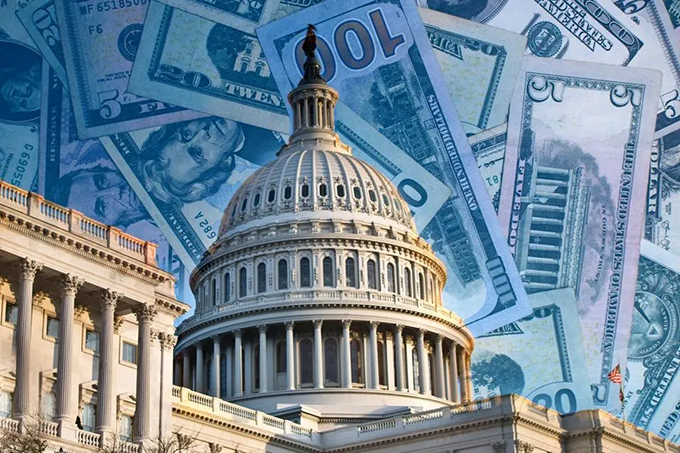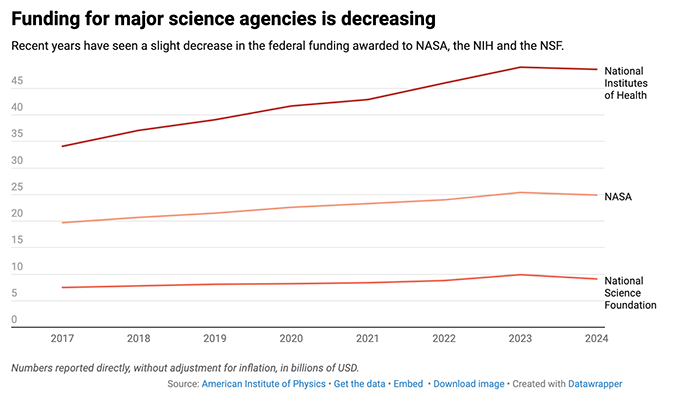
Government funding for science is usually immune from political gridlock and polarization in Congress. But, federal funding for science is slated to drop for 2025.
Science research dollars are considered to be discretionary, which means the funding has to be approved by Congress every year. But it’s in a budget category with larger entitlement programs like Medicare and Social Security that are generally considered untouchable by politicians of both parties.
Federal investment in scientific research encompasses everything from large telescopes supported by the National Science Foundation to NASA satellites studying climate change, programs studying the use and governance of artificial intelligence at the National Institute of Standards and Technology, and research on Alzheimer’s disease funded by the National Institutes of Health.
Studies show that increasing federal research spending benefits productivity and economic competitiveness.
I’m an astronomer and also a senior university administrator. As an administrator, I’ve been involved in lobbying for research funding as associate dean of the College of Science at the University of Arizona, and in encouraging government investment in astronomy as a vice president of the American Astronomical Society. I’ve seen the importance of this kind of funding as a researcher who has had federal grants for 30 years, and as a senior academic who helps my colleagues write grants to support their valuable work.
Bipartisan support
Federal funding for many programs is characterized by political polarization, meaning that partisanship and ideological divisions between the two main political parties can lead to gridlock. Science is usually a rare exception to this problem.
The public shows strong bipartisan support for federal investment in scientific research, and Congress has generally followed suit, passing bills in 2024 with bipartisan backing in April and June.
The House passed these bills, and after reconciliation with language from the Senate, they resulted in final bills to direct US$460 billion in government spending.
However, policy documents produced by Congress reveal a partisan split in how Democratic and Republican lawmakers reference scientific research.
Congressional committees for both sides are citing more scientific papers, but there is only a 5% overlap in the papers they cite. That means that the two parties are using different evidence to make their funding decisions, rather than working from a scientific consensus. Committees under Democratic control were almost twice as likely to cite technical papers as panels led by Republicans, and they were more likely to cite papers that other scientists considered important.
Ideally, all the best ideas for scientific research would receive federal funds. But limited support for scientific research in the United States means that for individual scientists, getting funding is a highly competitive process.
At the National Science Foundation, only 1 in 4 proposals are accepted. Success rates for funding through the National Institutes of Health are even lower, with 1 in 5 proposals getting accepted. This low success rate means that the agencies have to reject many proposals that are rated excellent by the merit review process.
Scientists are often reluctant to publicly advocate for their programs, in part because they feel disconnected from the policymaking and appropriations process. Their academic training doesn’t equip them to communicate effectively to legislators and policy experts.
Budgets are down
Research received steady funding for the past few decades, but this year Congress reduced appropriations for science at many top government agencies.

The National Science Foundation budget is down 8%, which led agency leaders to warn Congress that the country may lose its ability to attract and train a scientific workforce.
The cut to the NSF is particularly disappointing since Congress promised it an extra $81 billion over five years when the CHIPS and Science Act passed in 2022. A deal to limit government spending in exchange for suspending the debt ceiling made the law’s goals hard to achieve.
NASA’s science budget is down 6%, and the budget for the National Institutes of Health, whose research aims to prevent disease and improve public health, is down 1%. Only the Department of Energy’s Office of Science got a bump, a modest 2%.
As a result, the major science agencies are nearing a 25-year low for their funding levels, as a share of U.S. gross domestic product.
Feeling the squeeze
Investment in research and development by the business sector is strongly increasing. In 1990, it was slightly higher than federal investment, but by 2020 it was nearly four times higher.
The distinction is important because business investment tends to focus on later stage and applied research, while federal funding goes to pure and exploratory research that can have enormous downstream benefits, such as for quantum computing and fusion power.
There are several causes of the science funding squeeze. Congressional intentions to increase funding levels, as with the CHIPS and Science Act, and the earlier COMPETES Act in 2007, have been derailed by fights over the debt limit and threats of government shutdowns.
The CHIPS act aimed to spur investment and job creation in semiconductor manufacturing, while the COMPETES Act aimed to increase U.S competitiveness in a wide range of high-tech industries such as space exploration.
The budget caps for fiscal years 2024 and 2025 remove any possibility for growth. The budget caps were designed to rein in federal spending, but they are a very blunt tool. Also, nondefense discretionary spending is only 15% of all federal spending. Discretionary spending is up for a vote every year, while mandatory spending is dictated by prior laws.
Entitlement programs like Medicare, Medicaid and Social Security are mandatory forms of spending. Taken together, they are three times larger than the amount available for discretionary spending, so science has to fight over a small fraction of the overall budget pie.
Within that 15% slice, scientific research competes with K-12 education, veterans’ health care, public health, initiatives for small businesses, and more.
Global competition
While government science funding in the U.S. is stagnant, America’s main scientific rivals are rising fast.
Federal R&D funding as a percentage of GDP has dropped from 1.2% in 1987 to 1% in 2010 to under 0.8% currently. The United States is still the world’s biggest spender on research and development, but in terms of government R&D as a fraction of GDP, the United States ranked 12th in 2021, behind South Korea and a set of European countries. In terms of science researchers as a portion of the labor force, the United States ranks 10th.
Meanwhile, America’s main geopolitical rival is rising fast. China has eclipsed the United States in high-impact papers published, and China now spends more than the United States on university and government research.
If the U.S. wants to keep its status as the world leader in scientific research, it’ll need to redouble its commitment to science by appropriately funding research.
Author Bio: Chris Impey is University Distinguished Professor of Astronomy at the University of Arizona
